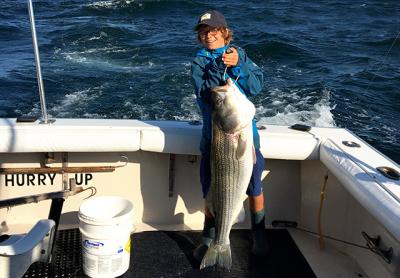Those Secret Sauces

Resting comfortably in the “if it ain’t broke, don’t fix it” side of the aisle, I’m a somewhat slow adopter of new fishing tackle technologies. I use braided lines for bottom fishing but still prefer grandpap’s stretchy monofilament for battling head-shaking species like bluefish. Scented and chemical attractant-infused soft-plastic baits like Gulp! from Berkley have been around since the 1980s, but I’ve never given much thought to using them instead of squid for fluke, sea bass, or porgy.
A few days ago, Sebastian Gorgone at Mrs. Sam’s Bait and Tackle in East Hampton told me that Gulp! has been flying off the shelf and that some local old salts are enthusiastic recent converts. If it’s good enough for these guys, maybe it’s time for me to put down my favorite bait-cutting knife, the one that can cut a piece of squid into perfect triangular pennants, and embrace the slippery and stinky live-bait alternative.
Decades ago some freshwater bass fisherman down below the Mason-Dixon line hypothesized that fish were repelled by scents transferred to lures and baits by human hands. They started adding scent-hiding agents to their offerings such as licorice-flavored anise oil. Later, others experimented with coffee, and, mama mia, garlic. These oddball schemes actually produced more catches, which prompted fishing products companies to begin selling a wide variety of scent-hiding and flavored products, including grape and strawberry worms. Yup, some freshwater fishermen use Gummy Bears for bait.
Today, Berkley and other manufacturers employ fish neurobiologists, chemists, and other scientists to create the liquids that coat their soft-plastic baits. These secret sauces fall into three categories: scent-masking, natural bait flavors such as shrimp and squid, and chemical stimulants and attractants, some with fear and aggression pheromones to trigger a sharp feeding response from fish. The formulations typically are water-soluble and can be detected by fish from a distance of several inches to several yards, depending upon the freshness of the bait, current speed, water temperature, and other factors.
Interestingly, studies have shown that two other water-soluble chemicals, PABA, an ingredient in sunscreen, and DEET, the active ingredient in most bug repellents, are repugnant to fish. An angler’s hands should be free of sunscreen and bug spray before handling the treated baits.
Gulp! and Gulp Alive! are probably the most popular saltwater soft-plastic bait products among local saltwater anglers. The chartreuse four-inch swimming mullet is a favorite for fluke and other species. Just rig the bait on a hook and send it to the bottom. Let science do all the work!
The advantages of using Gulp! and similar products are the relative durability of the product, storage convenience and long shelf life, and minimal bait preparation and cleanup. While there is a butcher’s joy in cutting off the head of a squid, removing its guts, and slicing it for the hook, most fishermen won’t miss the dripping squid ink and slimy fingers that go along with this process. That’s not to say that handling the soft-plastic products is a complete joy. The juice that covers the products attracts fish but repels humans. Reserve some of that licorice oil for your hands before returning home.
Before fish neurobiologists started tinkering with the smell of artificial baits on a molecular level, some good ol’ boys did a little testing on their own. Some tried soaking bait in Diet Pepsi, covering it with hot sauce, coating it with WD-40, spraying it with Mennen deodorant, and, no joke, applying the hemorrhoid cream Preparation H. Each claimed more fish were landed as a result.
In the 1970s, a University of Florida marine researcher started concocting fish-attracting potions in his lab. The school later licensed his formula under the name Gatorbait. That was about a decade after the university licensed a pretty successful sports drink, Gatorade.
The next time I head over to my favorit sea bass and fluke spot I’ll certainly bring along a package of soft-plastic bait soaked in chemical goodness. That’s if there are any left on the shelf.
The generally crummy weather kept many boats at the dock but those that ventured out during the small windows of fair conditions were rewarded.
The Viking Fleet in Montauk reported a successful 36-hour tuna trip on Saturday with a quick limit of yellowfin in the 50-to-70-pound range and a pair of bigeyes, one about 150 pounds and the other weighing in at 258 pounds. Fishing was consistent throughout the day and as many as seven fish were hooked simultaneously.
Harvey Bennett at the Tackle Shop in Amagansett reported that Nick Zuccitti caught a nice bull dolphin at Butterfish Hole on a Storm lure and 10-year-old Bennett Burki landed a 35-pound striped bass off Montauk Point.
Paulie’s Tackle in Montauk reported some small striped bass and blues were taken during the recent crummy weather but hardcore surfcasters continue to aggressively fish the roiling surf in the hope that the wind pushes larger striped bass to the rocky shores surrounding the Point.
Gorgone at Mrs. Sam’s Bait and Tackle said a few large kingfish were caught around Louse Point and bluefish of all sizes are roaming Gardiner’s Bay.
Harbor Marina of East Hampton announced the results of the 2016 Great Bonac Fishing Contest. Patrick Hilbert won first place in the striper division, E.J. McAlifee took first in the fluke division, Tim McAlifee had first in the sea bass division, and Drew Stein took the top place in the porgy division.
The marina, located at the end of Gann Road in East Hampton, will hold its 18th annual Snapper Derby on Sunday. Registration is at 10 a.m. and the weigh-in takes place from 1:30 to 2 p.m. Further details can be had at 631-324-5666.
Follow The Star’s fishing columnist on Twitter, @ehstarfishing. Photos of prize catches can be emailed to David Kuperschmid at [email protected].
